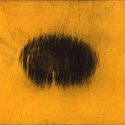Karlheinz Stockhausen (1928-2007) would not make many Top Ten Composers of All Time list — but he makes mine!
I first encountered his music when I was 15 (1967), and I knew the tingling in my ears meant that I had found something special. My beloved late father — who could sit and listen to Heifetz’s recording of the Beethoven Violin Concerto on forever-repeat — used to ask me why I considered this stuff music at all! Yet, he patiently listened, his body twitching when things got too weird, but I think he understood why I was so drawn to the awesome newness of these works.
I hardly expect to change too many minds — most people yell “noise” at the first moment — but I present you here 12 opportunities to sample a fraction of his work in chronological order on YouTube. Give it a chance. Open Thy Ears …
- Chöre für Doris (1950). A student work, Stockhausen sets three poems by Paul Verlaine, for a cappella chorus — 1) Die Nachtigall (The Nightingale); 2. Armer junger Hirt (A Poor Young Shepherd); and 3. Agnus Dei. He is learning how to actualize serial (12-tone) principles, much like the early works of his fellow student, Pierre Boulez.
- Kontra-Punkte (1952-53). For ten instruments, this performance by Ensemble Linea is excellent. As the title suggests, this composition is interested in a pointillistic approach to counterpoint. Each instrument plays a unique series of notes which combines with others to create an ethereal polyphony.
- Zeitmasse (1955-56). For woodwind quintet, except he replaces the French Horn with an English Horn. Again, the title tells all. Here he is concerned with time — foreshortened, quickened, and suspended in air molecules. The music is breathtaking and magical — the five members of the London Sinfonietta play with extraordinary comprehension and passion.
- Gruppen for three orchestras (1955-57). These French musicians perform! The work again uses a pointillistic approach to creating a whole. All three groups are completely synchronized, but in a live performance, the listener hears the voices coming from the different directions.
- Gesang der Jüngling (1955-56). Here — in one of Stockhausen’s early attempts at combining a human musical instrument (in this case, a boy soprano) with electronic sounds — he works with pitch resonance and electronically-produced phonemes. Stockhausen uses three types of electronic sound: 1) sine tones; 2) pulses/clicks; and 3) filtered white noise. The text is from the Book of Daniel.
- Klavierstuck XI (1956). The great French pianist Pierre-Laurent Aimard performs the 11th of Stockhausen’s “piano pieces.” Similar to Zyklus (below), the score consists of 19 fragments spread out over a single large page. The performer determines the sequence and finishes at a pre-determined point.
- Zyklus (1959). For solo percussionist. Alexander Smith delivers a knock-out performance of a spiral score which the performer must cut-and-paste, choose a starting point, and create a “cycle” of every imaginable percussive sound to create a unified whole. Smith’s videographer also did a magnificent job.
- Carré for four orchestras and four choirs (1959-60). Like Gruppen, spatial distribution of sound is the main concern. Eight basic categories of sound form the foundation (type, attack, gestalt variation, density, register, duration, amplitude, and color) are all further subdivided into four more detailed groups.
- Hymnen (1966-67). Here is Stockhausen’s greatest masterpiece, imho. The piece uses both electronic and concrete (real sounds) and is divided into four “regions” which feature various national anthems: Region I uses The Internationale and La Marseillaise; Region II features the Deutschlandlied, a group of African anthems, the beginning of Russian anthem, and a fragment of the Nazi-era Horst-Wessel-Lied; Region III continues the Russian, the Star-Spangled Banner, and the Marcha Real; Region IV features the Swiss Psalm.
- Stimmung (1968). For six singers who begin from a low B-Flat fundamental and in just intonation expand upwards through overtone singing. Stockhausen was inspired by his own meditation, creating vocal sounds that originate from different parts of the body — nasal, for example. Incorporated into the structure are “magic words” — gods and goddesses from many cultures; Aztec, aboriginal, ancient Greek, etc. This video streams a spectral analysis of the music from the Paul Hiller Theatre of Voices.
- Mantra (1970). For two ring-modulated pianos, with woodblocks, antique cymbals and short-wave radio. As usual, the structure is well thought out and complex.
- Licht (Die sieben Tage der Woche) (1977-2003) A cycle of seven operas — one for each day of the week. Licht consists of 29 hours of music.
Go to Source
Author: Lewis Saul
